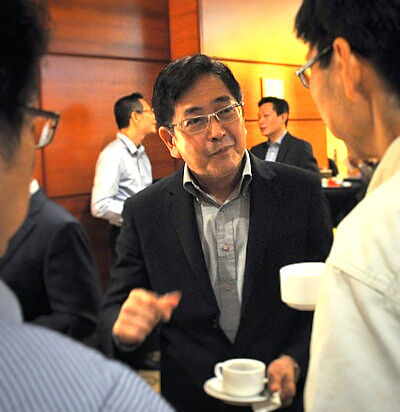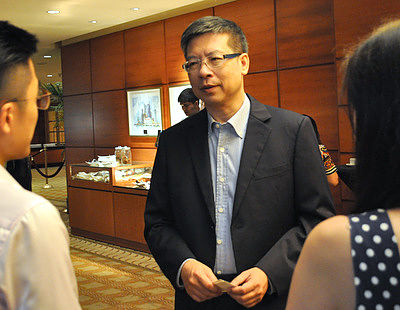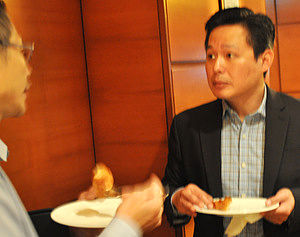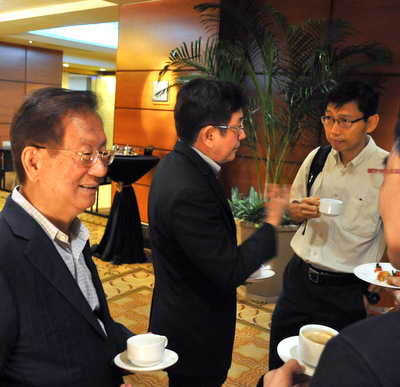|
From the FY15 results briefing:
Q: Could you provide some colour on the core business operations?
 Deputy CEO ELTay. Photo by Leong Chan TeikDeputy CEO EL Tay: Our core business operations in Q4 did very well. We also did well for the full year as compared to the year before. We expect and anticipate this trend to continue in 2016. Deputy CEO ELTay. Photo by Leong Chan TeikDeputy CEO EL Tay: Our core business operations in Q4 did very well. We also did well for the full year as compared to the year before. We expect and anticipate this trend to continue in 2016.
As you know, traditionally, the first quarter of the year has always been a challenge due to seasonality and demand fluctuations for our customers. We expect that to be over soon.
As we get into the rest of the quarter, we expect revenue to be higher than last year. All in all, we remain positive about our core business.
Executive chairman Yao Hsiao Tung: Loading in our tooling business is very healthy going into 2016. This is a good scenario for us. At Hi-P, we have a good reputation in both tool making and in our moulding processes. Many customers come to Hi-P when they want to make difficult parts as we provide good solutions.
In the last several years, our tooling performance has been good and our moulding business has remained busy. Recently, our tooling management has been enhanced tremendously.
Because of this, I believe our tooling business will continue to be loaded in 2016. Our moulding business will also increase by quite a lot. This will help our 2016 growth.
Q: Could you elaborate on the provisions you made for the Yota project? What actually happened? Please also touch on the type of inventory your provisions relate to.
CFO Samuel Yuen: If you look at the total exposure, it is USD 126 million. We have provided SGD 76.9 million, roughly USD55 million. If you take away the USD 15 million in the escrow account, it is about USD 111 million.
 CFO Samuel Yuen. Photo by Leong Chan TeikAs a whole, we roughly have provisions amounting to 50% of the exposure. Of which, roughly 80% of the provisions are related to inventory, 10% related to non-cancellable purchase orders which we are negotiating with suppliers for a haircut but of course they will ask us for some compensation, another 10% is related to accounts receivable. We still have the inventory on our side. We will continue sell the inventory and keep the proceeds. CFO Samuel Yuen. Photo by Leong Chan TeikAs a whole, we roughly have provisions amounting to 50% of the exposure. Of which, roughly 80% of the provisions are related to inventory, 10% related to non-cancellable purchase orders which we are negotiating with suppliers for a haircut but of course they will ask us for some compensation, another 10% is related to accounts receivable. We still have the inventory on our side. We will continue sell the inventory and keep the proceeds.
Q: What type of inventory is this?
Samuel: These are finished goods. At the same time we have deployed some of the component raw materials into other projects.
EL: Let me just add from a business prospective, as you know in the cell phone industry, the average selling price comes down quarter on quarter. This particular Yota phone was launched more than a year ago and because of the slow moving channels, we have seen the deterioration of the price and that is why we have to take a write-off in terms of reevaluating the inventory. We are still working with various distributors in China as well as outside of China to move the products. We will continue to do so aggressively throughout the quarter.
Q: Does it mean that going forward, in every quarter that you are not able to sell the stock, you will have to make further impairments as the cost of the goods have gone down?
EL: We do not expect that. As Samuel has mentioned, we have taken a 50% provision on the value of the inventory. We think that that will be sufficient for us to clear the rest of the inventory.
Q: Have you reached a conclusion on the Yota incident or is this still ongoing?
EL: We are still negotiating with them and the arbitration process is still ongoing. Once we have new developments, we will announce it accordingly. For today’s announcement, we are taking an internal, proactive approach to value the inventory.
Q: For your expected higher revenue in 2016, which customer will this come from? Could you elaborate on this expected higher revenue?
Chief Operating Officer Gary Ho: We are actually seeing momentum from existing customers as well as new customers that we have acquired along the way. We have tried to grow our market share on multiple fronts.
 Chief Operating Officer Gary Ho. Chief Operating Officer Gary Ho.
Photo by Leong Chan TeikOne -- the traditional business in moulding and CNC. The other is working on new products such as providing ODM design and manufacturing. We also want to grow our consumer electronics business. We are currently seeing growth in all four areas.
Q: Referring to your forward guidance statement, you said you expect to be profitable in 2016. Will your core operating profit level be higher in 2016?
EL: Actually it’s too early in the year to tell you the projections for the full year. Do come for the next two briefings for us to provide you with updates along the way.
However, in the last quarter, we have taken a key initiative in the company to continue to drive down costs across all departments. We are taking a proactive approach to remain competitive in our cost structure as well as in the cost of manufacturing. This should translate into additional cost savings in 2016.
Q: With regard to your margins in 2016, do you expect your customers to do a cost down or do you expect margins to remain the same?
EL: Right now we expect the margins to be in the ball park that we have experienced in the last two years. Cost down is pretty common in the market now. The customer always expects and wants the supplier to cost down. This is a key reason why we have to look at ways to improve our cost structure.
|











